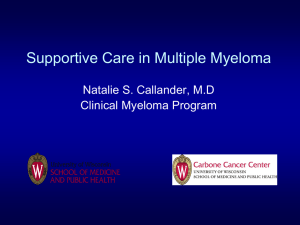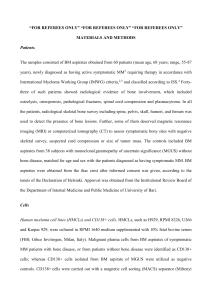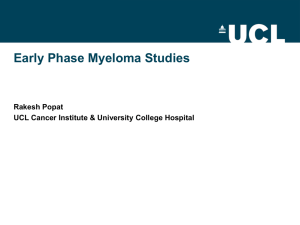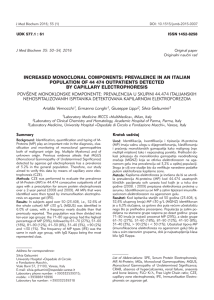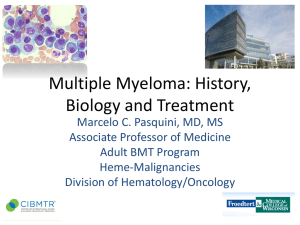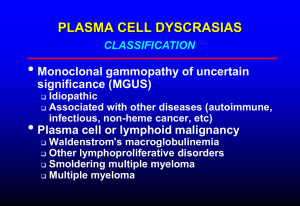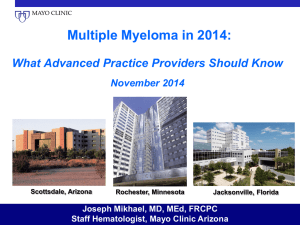Projected Presentation Template
advertisement
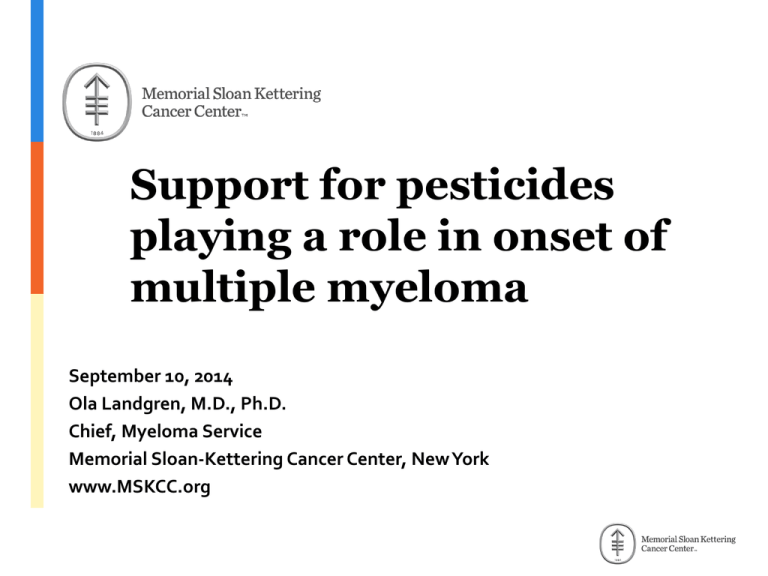
Support for pesticides playing a role in onset of multiple myeloma September 10, 2014 Ola Landgren, M.D., Ph.D. Chief, Myeloma Service Memorial Sloan-Kettering Cancer Center, New York www.MSKCC.org What is multiple myeloma? Multiple myeloma • Second most common blood cancer in the U.S.; over 83,000 affected in 2014 • Bone marrow cancer (plasma cells) • No established curative treatment; average survival 5-7 years Multiple myeloma: abnormal plasma cells in the bone marrow Multiple myeloma: lytic bone lesions Hillengass and Landgren. Leuk Lymphoma 2013 Multiple myeloma: genetic heterogeneity within each patient Lohr et al. Cancer Cell 2014 Multiple myeloma and its precursor “MGUS” Cumulative risk (%) of myeloma “Monoclonal gammopathy of undetermined significance” (MGUS) Risk of developing multiple myeloma (0.5-1% per year) Year of follow-up Kyle, Am J Med 1978; Turesson et al. Blood 2014 Myeloma consistently preceded by precursor state “MGUS” >77,000 cancer free men and women; stored annual blood tests Up to 10 years of follow-up Landgren et al. Blood 2009 Multiple myeloma (n=71) Risk factors for multiple myeloma; what are the causes? Risk factors for multiple myeloma; what are the causes? • • • • • • Older age Male gender Family history of myeloma African American descent Obesity Farming/pesticides Rusiecki et al, Env Health Perspect 2009 Agricultural Health Study • Cancer incidence among pesticide applicators exposed to permethrin • Permethrin: synthetic pyrethroid insecticide widely used in agriculture and many U.S. homes and gardens • Prospective cohort 49,093 licensed pesticide applicators in Iowa and North Carolina • Self-administered questionnaires; average follow-up 9 years Rusiecki et al, Env Health Perspect 2009 Agricultural Health Study: myeloma • No excess risk for non-Hodgkin lymphoma, leukemia, melanoma, cancers of the colon, rectum, lung, or prostate • 6-fold excess risk of multiple myeloma, compared with applicators reporting never used permethrin • Results based on 15 exposed cases • Findings similar across variety of alternative exposure metrics, exposure categories, and reference groups; warrants further evaluation Rusiecki et al, Env Health Perspect 2009 Agricultural Health Study: MGUS Landgren et al, Blood 2009 Agricultural Health Study: MGUS • 678 pesticide applicators (30-94 years) participated to assess risk of MGUS • Serum samples analyzed by electrophoresis; discrete or localized band subjected to immunofixation • Age-adjusted prevalence compared with MGUS prevalence in 9469 controls from Minnesota Landgren et al, Blood 2009 Agricultural Health Study: MGUS • 38 had MGUS (prevalence 6.8%); age-adjusted prevalence 2-fold higher in pesticide applicators • Excess risk of MGUS associated with chlorinated insecticide dieldrin, the fumigant mixture carbontetrachloride/carbon disulfide, and the fungicide chlorothalonil • These findings support hypothesis that specific pesticides causatively linked to myelomagenesis Landgren et al, Blood 2009 National Health and Nutritional Examination Survey (NHANES) Landgren et al, Leukemia 2014 NHANES Study • Stored serum samples from 12,482 individuals >50 years (NHANES III and NHANES 1999–2004) • Serum samples analyzed by electrophoresis; discrete or localized band subjected to immunofixation • Define prevalence and risk factors of MGUS in large cohort representative of US population Landgren et al, Leukemia 2014 NHANES Study • Prior study from Olmsted County, Minnesota, found 3.2% MGUS prevalence • NHANES overall MGUS prevalence was 2.4% (2.3% in whites) • Interestingly, MGUS prevalence was 3.1% in North/Midwest and 2.1% in South/West, respectively (P=0.052) Landgren et al, Leukemia 2014 NHANES Study • According to SEER; death rates from multiple myeloma much higher in Minnesota than other regions of the country • The observed strong geographic disparity in prevalence of MGUS between the North/Midwest versus the South/West regions of U.S. has etiologic implications Landgren et al, Leukemia 2014 Summary and conclusions Summary and conclusions • Studies show pesticide exposure associated with MGUS and multiple myeloma • Geographic disparity of MGUS/multiple myeloma: high prevalence in North/Midwest • Ongoing studies to confirm findings and better understand underlying mechanisms Selected ongoing studies (collaborators) • Agricultural Health Study: part II (NCI) • Agent Orange exposed veterans (CDC/VA) • World Trade Center rescue workers (FDNY/Albert Einstein College of Medicine) Thank you for your attention! Ola Landgren, M.D, Ph.D. Chief, Myeloma Service Memorial Sloan-Kettering Cancer Center 1275 York Avenue, New York, NY 10065, USA Email: landgrec@mskcc.org Phone: 212-639-5126
